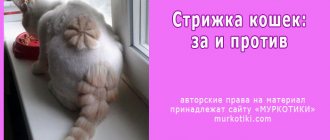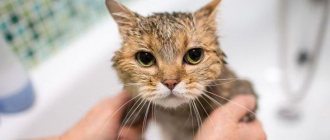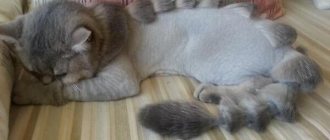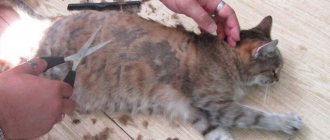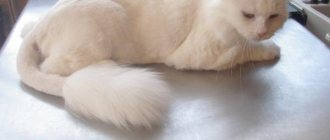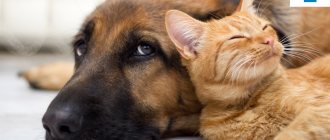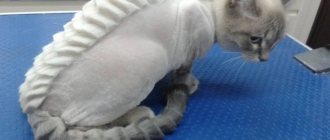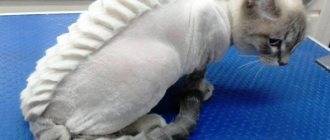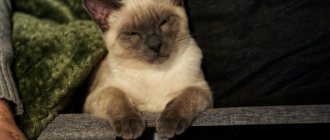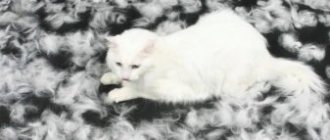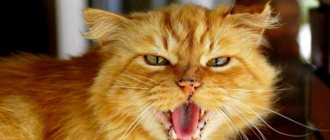The list of pet care services is very large. Owners are offered to cut, dye or style their cat's fur. Not everyone understands the need for such procedures and does not share the delight at the sight of a domestic cat cut like a lion. Usually people do not understand why owners of short-haired breeds cut their cats. For them, caring for their pet's appearance consists only of bathing. Owners of long-haired breeds can only envy them - after all, caring for long hair requires certain skills and a lot of patience.
Is it true that cats can be cut?
For cats that live in the private sector and spend a lot of time outdoors, careful care is essential. After a walk, your pet may return not only with dirty hair, but also with hair matted into lumps. In this case, scissors will come to your aid. And if your pet has long, thick hair, then to avoid such troubles it makes sense to get a beautiful haircut with the onset of the warm season. If your cat is domestic, and you have enough time, effort and patience to take care of your pet’s fur every day and keep it clean and tidy, you can avoid going to the “cat” hairdresser - groomer. Even if there is no need to cut your pet’s hair, it is advisable to use a fuminator or slicker; they comb out the dead undercoat without touching the living one.
How often can you cut your hair?
The frequency of cosmetic procedures depends on the age of the animal, its health, and the rate of hair regrowth. It is recommended to trim your cat 2-3 times annually. Unscheduled ones are done as needed - before exhibitions, competitions. However, an exception is sometimes made for longhaired dogs. Especially with poor hygiene. Then they trim and shave as needed or every three months.
Some cats have a hard time withstanding heat (for example, Persians). Therefore, it is recommended to cut them in spring and summer. Such rocks quickly become overgrown, so they are trimmed 2-3 times annually. Less often – cats with medium pile. For them, it is enough to trim the animal once every 12 months. In addition, a well-groomed pet is easier to treat for parasites and skin diseases.
Why do you need a haircut?
Owners of furry pets have different opinions on this issue. Some are categorically against such a procedure, because they sincerely believe that the haircut disfigures the cat. And others not only take their pet to the hairdresser, but also maintain a regular schedule. There are several main reasons explaining why cats need a haircut: - Due to the increased body temperature of cats compared to humans, they can easily tolerate hot summer weather, but if the temperature outside exceeds 35-40 degrees, cats begin to feel unwell. If you decide to cut your pet’s hair to make its life easier, follow certain rules, or better yet, consult a specialist. He will calculate the required length of fur that needs to be left for the pet so that he does not become vulnerable to direct sunlight or catch a cold from a draft and air conditioning. — The appearance of bald patches on a pet’s body often frightens owners and leads to unplanned haircuts. But when the hair grows back, the bald patches remain. In this case, hairdressing services are not able to solve the problem, contact your veterinarian to find the cause and begin timely treatment. — During shedding, caring for a cat takes a lot of time and effort, and cleaning an apartment where fur constantly flies around is not fun. There is an opinion that if you cut an animal's hair, the problem will be resolved. This is a mistake - after growing overgrown, the cat will begin to shed again. If shedding time is delayed, contact your veterinarian. The specialist will find the reason, perhaps it is high humidity in the room, stress in the pet, or improper feeding. — Not all owners find a common language with their pet; cats simply do not allow themselves to be brushed. Thus, tangles form on the animal’s body, which tighten the skin, cause itching, and cause discomfort. A nest for fleas, fungi and various infections is formed under the mat. If your cat has thick, long hair, pay special attention to its care. — Another reason is the cohabitation of a cat and a person with upper respiratory tract diseases and allergies. Grooming cats will help allergy sufferers and asthmatics avoid a trigger (a factor that causes suffocation and exacerbation of the disease). — It happens that the pet is sick or too old. If an animal cannot properly care for its fur, a haircut will also help. - Pets need to be cut to be simply beautiful! This is especially true before exhibitions. A groomer will help you with a model haircut. It can be original, emphasizing the individuality of the pet.
Negative consequences and contraindications
After trimming and shaving, minor problems may arise. For example, skin damage during games. Other consequences:
- When an animal is bothered by growing hairs, it begins to itch or does it out of habit.
- The animal licks itself more often, which can lead to slight skin irritation.
- Some cats become depressed, they hide, and begin to take revenge on their owners.
- The structure of the pile changes. Its quality deteriorates, the hairs become thinner, become tangled, and new tangles form faster. This sometimes becomes a reason for disqualification, as the coat no longer meets the breed standard.
- Color may change.
- The elasticity and firmness of the skin decreases.
- When the whiskers are injured, the cat loses orientation, coordination is impaired, and moves uncertainly.
- Cuts provoke the development of inflammation.
- Sometimes hair growth stops in the shaved area. Then, after restoration of the cover, areas of baldness remain.
- Shaving a cat bald disrupts thermoregulation, which causes the development of dermatological diseases, frequent colds, sunburn, and increases the risk of skin injuries.
- An incorrectly done haircut can provoke a cat's desire to bite off its own tail.
Behavior changes less frequently and aggression appears. The cat may suddenly begin to attack, tear up furniture, or walk past the litter box. Usually this is a short-term phenomenon, otherwise the pet needs to be taken to the veterinarian. Some cats are prohibited from being groomed:
- With color-point, tipping color . Otherwise, after cutting, the color of the pile will become darker.
- Shorthair (especially Scottish Fold, British). The exception is varieties of these breeds with long pile.
- Semi-longhaired (Mae Coon, Norwegian Forest, Siberian). Pile saves animals from heat and cold.
Hyperactive cats are not groomed. Otherwise, the procedure is carried out under anesthesia, after sedatives, and it can be difficult to moderate their ardor. Do not shave the inside of the ears or paw pads. It is prohibited to administer anesthesia to animals with chronic diseases. Even healthy people can have heart failure after it.
To cut or not to cut your pet?
During a grooming, a cat gets stressed, which can lead to unpleasant consequences. However, the determining factor is the climate in which you live and where the pet spends most of its time - outdoors or indoors. When it's very hot outside and you want to help your four-legged friend, a haircut won't be a bad idea. Despite the obvious benefits (especially for long-haired cats), clipping has some disadvantages. A trimmed animal adapts less well to temperature changes. Cats walking outside can overheat in the sun, since their skin will not be protected by fur, and the pet can catch a cold. Therefore, you should not get carried away with this procedure. It is necessary to organize proper coat care, in this way you can avoid the formation of tangles and, as a result, the occurrence of skin diseases.
How long does a cat's hair grow after shaving?
How long a cat's fur grows after trimming and shaving is mainly influenced by genetics and nutritional balance. For example, my cat gained about 2 mm in length in 1-2 days. This is the normal rate of hair growth for cats. At first it looked like a waffle towel - a pitiful sight, although it was pleasant to touch (reminiscent of a mouton). Two weeks passed and the animal was in more or less decent shape. After about six months, as the groomers promised, the coat regained its previous length. On average, this is what happens.
However, as expected, the blue point cat was very dark on the body. It looks disgusting, so we're waiting for it to fade. There is little hope that after molting, the previous light shade will at least be restored a little.
But many owners complain that the cat’s hair does not grow well after a haircut. This also happens. And in rare cases, there may be areas of baldness where the hair does not recover at all.
Everything you need for a haircut
Of course, to cut a cat's hair, it is better to turn to specialists, but you can do a simple haircut yourself at home. The fur of different cat breeds varies in length, stiffness and density, and each pet will require a different approach. You will need:
- Table (you can use an ironing board);
- Scissors;
- Comb;
- Hair clipper (preferably with veterinary attachment No. 3);
- Hydrogen peroxide or iodine (in case of accidental injury to the pet's skin).
Before you start grooming your cat, be sure to trim its nails.
The right tools
But let's say you have a good reason. Then you need to stock up on the right tools. You can, of course, try to shave a cat with a human clipper, but this usually leads to injuries and a poor-quality haircut. Human and animal hair differ in structure and thickness, so clippers for cats and dogs are different in a number of ways. And it’s also better not to use an ordinary razor, that is, a machine: the cat will resist - then you can injure both it and yourself. In addition, shaving with a machine is inconvenient.
The procedure is performed with a special cat shaving machine. It can be purchased in online stores. It is advisable to choose a machine with a power of at least 45 watts. Cat knives are usually produced in the following sizes:
- 0.5 mm (when you need to open a place for hygiene procedures);
- 1.5-1.6 mm (when you need to remove very matted hair close to the skin);
- 3.2 mm (standard shaving).
It is the length of 3 mm with a slight plus that allows you to ensure that the fur remains soft enough and does not prick, causing itching. But if you use a knife much longer than 3 mm, noticeable transitions with jagged edges will appear, which looks careless.
How to properly cut a cat's hair
When cutting hair, it is advisable to find an assistant. He will hold the animal lying on its side, control the front legs with one hand and the hind legs with the other. It is necessary to fix the pet on the table surface quite firmly - the cat will escape out of fear, and the sound of the running machine will provoke it to escape. Try to use silent machines. It is necessary to cut cats according to a certain algorithm: start cutting from the sides, back and belly, move to the armpits, then the back. Then come the paws; if you wish, you can leave the “socks”. It is not necessary to cut the tail, but if you decide to tidy it up, leave a tassel at the end. If you decide to cut your cat's hair against the grain, use scissors and a special clipper, setting the cutting depth to 3 to 4 mm, which will prevent injury to the animal's skin. Do not forget to stretch the animal's skin in the area where the machine passes. Cutting against the grain is different in that a larger volume of hair is removed in one pass, but this method is mentally traumatic for the animal. After finishing the haircut, wipe the cat with wet wipes, or better yet, give it a bath to remove any remaining fur. Now all the fears are over, and she is ready to return to her normal life. This process is not simple, it has many nuances, and not all animals tolerate haircuts calmly. If you do not have enough skills to groom your pet on your own, it is better to contact a groomer: go to a special salon or call them to your home.
Is it possible to shave a cat bald?
The answer to the question whether it is necessary and whether it is possible to cut a cat’s fur will be both “yes” and “no”. You definitely can’t completely shave a cat. But a 3 mm haircut is sometimes indicated. There are situations in which a cat needs to be shaved. These are, first of all, medical indications for such a procedure as a hygienic haircut:
- foci of fungus and other skin infections;
- a large number of tangles, when it is easier to shave them than to cut them out;
- weeping wounds and ulcers: shaving in such cases is indicated on the affected areas to make it easier to apply medications;
- the animal became so dirty that it was impossible to wash it off;
- shaving certain areas before surgery and ultrasound;
- the animal sheds heavily and swallows a huge amount of hair, which creates a threat of blockage of the gastrointestinal tract: in this case, you can shave until the cause of excessive shedding is eliminated.
Shaving, indeed, allows you to stop severe shedding when the house is literally drowning in fur. This helped in our situation: we went to the groomers with a request to comb out the hair, but in the end they solved the problem completely. Naturally, if the cat is prone to such shedding, as soon as the fur grows back and the season comes, the problem will arise again. Those. shaving, in fact, does not solve the problem, but only hides it: short hairs continue to fall out, but this is no longer noticeable.
What happens if you shave a cat's head directly depends on the color and individual mental traits of the cat, as well as on the conditions in which it lives. For example, smoke-colored cats are cut and shaved with great care, but color-point cats should not be cut or shaved. Many who are reading these lines now will object, they say, they have points, they were shaved - and everything is fine. Yes, some points are fine. But in the classic version, the points darken after that. Tested on mine and many other cats. Smoky and tipped colors also run the risk of deterioration.
Article continues after advertisement
As for other conditions, many cats have a psychologically difficult time with the shaving process and its consequences. And also, because In cats, after shaving, the heat exchange that is maintained by the hair is disrupted; in the first time after the procedure, the cat may freeze, even despite the warmth around.
Pros and cons of grooming
The main advantages of grooming British cats are compliance with cat “fashion” and minimizing the grooming procedure. As for the minuses, there are many more of them:
- Skin without hair becomes overcooled, overheats and dries out.
- The structure of the hair changes - after cutting it becomes thin and less elastic.
- Wool and undercoat grow simultaneously, which is contrary to natural processes. When shedding, they do not fall out together; the undercoat changes more often.
- After a haircut, a temporary loss of orientation is observed, which is caused by the removal of the whiskers located on the cat’s body.
In the examples with the British breed, all of the above events can have negative consequences. These cats have a complex character and attempts to force a pet to do something against its will are met with hostility.
